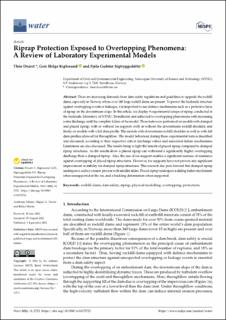| dc.contributor.author | Dezert, Theo | |
| dc.contributor.author | Kiplesund, Geir Helge | |
| dc.contributor.author | Sigtryggsdottir, Fjola Gudrun | |
| dc.date.accessioned | 2023-01-24T15:08:12Z | |
| dc.date.available | 2023-01-24T15:08:12Z | |
| dc.date.created | 2022-09-09T12:03:51Z | |
| dc.date.issued | 2022 | |
| dc.identifier.citation | Water. 2022, 14 (17), . | en_US |
| dc.identifier.issn | 2073-4441 | |
| dc.identifier.uri | https://hdl.handle.net/11250/3045966 | |
| dc.description.abstract | There are increasing demands from dam safety regulations and guidelines to upgrade the rockfill dams, especially in Norway where over 180 large rockfill dams are present. To protect the hydraulic structure against overtopping events or leakages, it is important to use defence mechanisms such as a protective layer of riprap on the downstream slope. In this article, we display 9 experimental setups of riprap, conducted at the hydraulic laboratory of NTNU (Trondheim) and subjected to overtopping phenomena with increasing water discharge, until the complete failure of the model. These tests were performed on models with dumped and placed riprap, with or without toe support, with or without the downstream rockfill shoulder, and finally on models with a full dam profile. The models with downstream rockfill shoulder as well as with full dam profiles allowed for throughflow. The model behaviour during these experimental tests is described and discussed, according to their respective critical discharge values and associated failure mechanisms. Limitations are also discussed. The results bring to light the benefit of placed riprap compared to dumped riprap structures. As the results show a placed riprap can withstand a significantly higher overtopping discharge than a dumped riprap. Also, the use of toe support enables a significant increase of resistance against overtopping of placed riprap structures. However, toe supports have not proven any significant improvement in stability for dumped riprap structures. This research also puts forward that dumped riprap undergoes a surface erosion process with smaller slides. Placed riprap undergoes a sliding failure mechanism when unsupported at the toe, and a buckling deformation when supported. | en_US |
| dc.language.iso | eng | en_US |
| dc.publisher | MDPI | en_US |
| dc.rights | Navngivelse 4.0 Internasjonal | * |
| dc.rights.uri | http://creativecommons.org/licenses/by/4.0/deed.no | * |
| dc.subject | Dambrudd | en_US |
| dc.subject | Dambreak | en_US |
| dc.subject | Dam failure | en_US |
| dc.subject | Dam failure | en_US |
| dc.title | Riprap Protection Exposed to Overtopping Phenomena: A Review of Laboratory Experimental Models | en_US |
| dc.title.alternative | Riprap Protection Exposed to Overtopping Phenomena: A Review of Laboratory Experimental Models | en_US |
| dc.type | Peer reviewed | en_US |
| dc.type | Journal article | en_US |
| dc.description.version | publishedVersion | en_US |
| dc.subject.nsi | VDP::Hydroteknologi: 538 | en_US |
| dc.subject.nsi | VDP::Hydrotechnology: 538 | en_US |
| dc.source.pagenumber | 14 | en_US |
| dc.source.volume | 14 | en_US |
| dc.source.journal | Water | en_US |
| dc.source.issue | 17 | en_US |
| dc.identifier.doi | 10.3390/w14172722 | |
| dc.identifier.cristin | 2050279 | |
| dc.relation.project | Norges forskningsråd: 257588 | en_US |
| cristin.ispublished | true | |
| cristin.fulltext | original | |
| cristin.qualitycode | 1 | |

